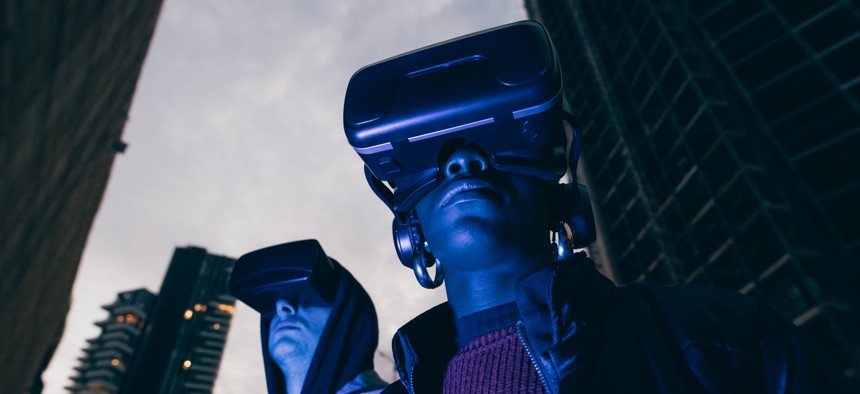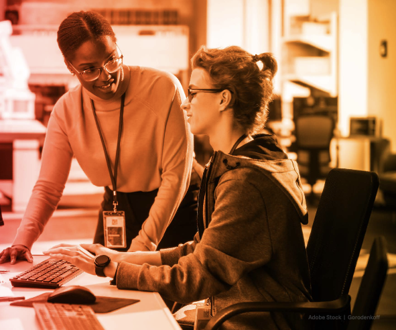Get ready for the metaverse

Eugenio Marongiu / Getty Images
While the metaverse may seem over the horizon, the National League of Cities says many cities are already experimenting with metaverse-enabling technologies: the internet of things, digital twins and blockchain.
In the metaverse, virtual real-estate firms and big-name retailers are staking out digital property storefronts. Entrepreneurs are starting businesses and selling homes, clothes and experiences to avatars whose human counterparts explore the virtual world through VR goggles and make payments with cryptocurrency.
One California city is dipping its virtual toe into the metaverse.
Santa Monica offers users who download FlickPlay, a social gaming app, the chance to collect tokens as they move through and a mixed-reality version of the city’s retail district. Players can redeem their tokens for physical items at area restaurants, parks and businesses and experience some what’s possible in a Santa Monica slice of the metaverse.
While the metaverse seems over the horizon for most cities, many are already experimenting with metaverse-enabling technologies: the internet of things, digital twins and blockchain, according to an April 18 report from the National League of Cities: How Cities Are Engaging in the Metaverse.
IoT solutions provide data about a city’s physical space, resources use and how people move about. While they’re often used to monitor traffic and track air quality, noise and temperature, the IoT data collected about the real world is “foundational” to augmented and virtual reality applications that make up the metaverse, the report said.
Cities are installing IoT-capable streetlights that can support monitoring and detection technologies along with charging stations, information displays and artificial intelligence applications. Cary, N.C., is using IoT flood monitoring to predict when to close roads or greenways and reroute traffic to prevent drivers from encountering floodwaters.
Digital twins, or 3D virtual models of a physical space, allow city planners, developers and even public safety officials to see detailed models of interiors, buildings and neighborhoods that they can use for testing various development or safety scenarios that involve complex, connected infrastructure.
Boston’s Planning and Development Agency has created a digital twin that maps the city’s physical landscape, from water and sewer systems to tree canopies, to see how changes will affect a neighborhood. Chattanooga partnered with the Energy Department’s Oak Ridge National Laboratory and the National Renewable Energy Laboratory on digital twins to increase energy efficiency while also optimizing drivers’ travel time, speed and safety.
Researchers are working to build a digital twin of Galvaston, Texas, to help planners and citizens get a better understanding of how changes to physical infrastructure can affect a community’s resilience to severe storms and coastal flooding. In January, Las Vegas announced its plans to use digital twins to model energy use, emissions, mobility and emergency management as it works to address sustainability goals.
The metaverse will be built on a blockchain, or distributed, platform to allow secure exchange of currency as well as decentralization, security, privacy and interoperability.
In 2018, Austin, Texas, piloted a program to give people experiencing homelessness a digital identity stored on blockchain. The system securely stored key identifying documents, such as a Social Security numbers or medical records, that are necessary to access services or medical care. As part of its smart city program, Lafayette, La., launched a blockchain application to manage maintenance and safety of the city’s vehicles, according to the report.
Cities are also using blockchain to track records. Last summer, Medici Land Governance announced it would be working with New York City’s Department of Finance to develop a blockchain proof-of-concept that would make data in property documents transparent and immutable and detect and reduce deed fraud. Wise County, Va., is also developing a blockchain program to create, store and access smart land records. And a proof of concept in Riverside County, California, allows customers to select the records they need, authenticate themselves, pay for the copies and receive blockchain-secured digital documents within minutes.
Miami is set to become the first major U.S. city to introduce a decentralized indoor and outdoor air-quality monitoring network built on the Algorand blockchain. PlanetWatch, a French company specializing in leveraging green technologies, plans to build an internet-of-things network of third-party compact air-quality monitors throughout Miami, which will transcribe data to the Algorand blockchain. The aggregated sensor data will help detect pollution hotspots and power environmental analytics to monitor Miami’s air quality.
“The technology and vision to create these kinds of virtual spaces and facilitate meaningful interpersonal interactions within them is finally here, and the impacts to society are not yet entirely understood,” the report said. “Leaders need to think about what these technologies will mean for cities as they plan for the years and decades ahead.”






